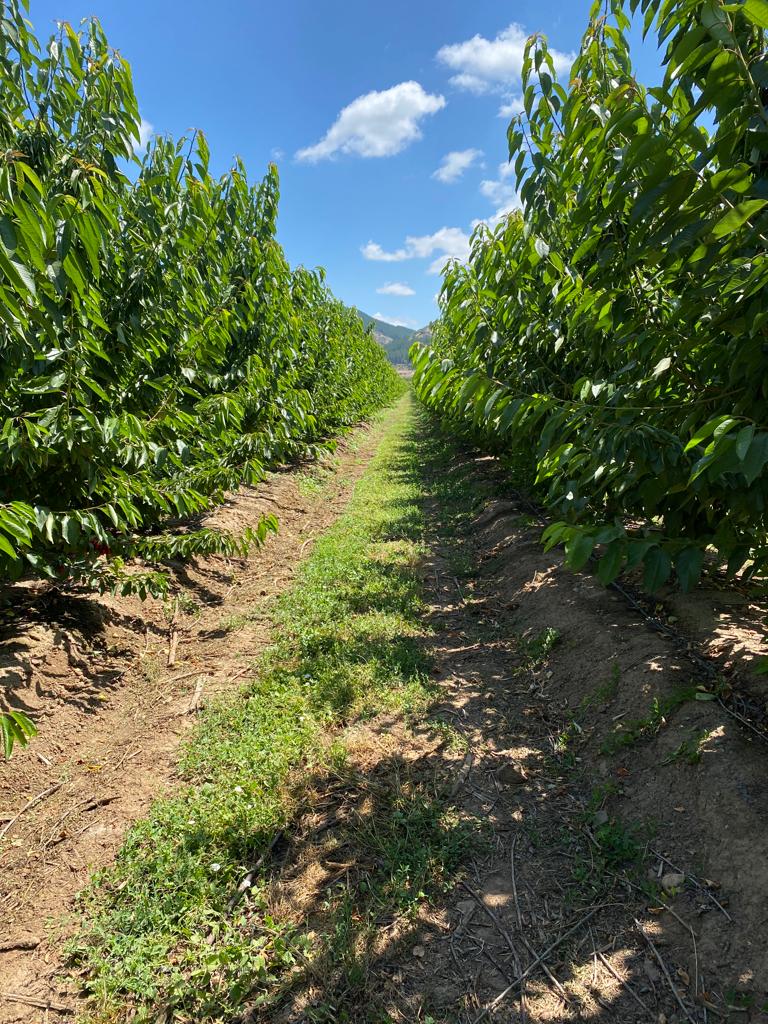By:
Avium Technical Team.
With the collaboration of Hugo Navarro A. Graduate of Agronomy PUC.

Frost is a meteorological phenomenon where the ambient temperature drops to the freezing point of water, that is, below 0° Celsius, due to radiative cooling from the ground to the atmosphere, which generates a thermal inversion that reaches from 5 to 20 meters high. This type of frost is known as "radiative or white frost" due to its characteristic color due to the frost it produces, being the most common. On the other hand, when the thermal inversion is caused by the descent of a mass of cold air coming from high latitudes, it is called "convective, polar or black frost", due to the absence of frost in its path, although much more harmful than the previous one, since by not forming frost or ice, the water cannot release heat in this process of changing from liquid to solid state, bringing disastrous consequences for the agricultural sector in general, damaging crops, especially when they happen unexpectedly and in areas where they do not normally occur.
Damage caused by low temperatures and/or freezing can occur in all plants, but the mechanisms and types of damage vary considerably. Thus, in general, different species or crop varieties show different damages caused by frost at the same temperature and in the same phenological stage.
Frost damage occurs when ice forms inside plant tissue, causing damage to plant cells. The formation of ice crystals within the protoplasm of plant cells is direct frost damage (intracellular frost), while indirect frost damage is the formation of ice inside the plant but outside the cells (extracellular frost), and it is the formation of ice, not the cold temperatures, that actually damages plants.
Figure 1. Visual appearance of flower primordia on cherry buds, before (A) and after (B) exposure to a frost event. (Source: Valenzuela et al. 2020)


The freezing of tissues and the degree of damage they cause can be explained by studying the process of cooling and freezing the water they contain, specifically, by the speed of freezing and thawing. Rapid cooling has an irreversible effect and causes serious damage when it occurs, since ice forms quickly in the meatuses (space between cells) and inside the cells, and the cells are unable to adapt. The cell membrane and the constituents of the protoplasm break down, which causes cell death and, therefore, a blackening of the cells. On the other hand, in slow cooling, the cells can gradually adapt to the changes, but as the extracellular water freezes, an escape of intracellular water occurs to compensate for the osmotic deficit that is produced and its content becomes concentrated. Although the tissues can survive and recover, the cells can die due to both denaturation processes and mechanical effects (Urbina, 2007).
The adaptation of plants to cold temperatures before a frost is called “hardening” and is probably related to increased solute content in plant tissue or decreased concentration of ice-nucleating bacteria (INA) during cold periods, or may indeed be a combination of both. The accumulation of sugars or sugar alcohols would lower tissue freezing temperatures and increase supercooling in many deciduous and evergreen trees at low air temperatures.
The level of assimilates in plant tissues is an active process in which the degree of response to frost or "hardening" would be subject to the previous conditions before the frost periods.
During the summer season in the post-harvest of the cherry tree, the concept is to avoid abiotic stress with respect to high temperatures by using different strategies to reduce this condition, and thus improve the physiological processes of accumulation of reserves in the different organs of the plant; however, indirectly, work is being done so that the reproductive structures can form a kind of "tolerance" or technically called a "hardening" to low temperatures given the better conformation of the buds in the cultivar.
When it comes to cherry plantations, a frost can cause the same damage as to any other species, however, the consequences of freezing will depend on the phenological state of the plant when the frost occurs.
For several years in Chile, it has been agreed that frosts are more severe the more advanced the phenological stage of the fruit tree is, however, in recent times this perception has been changing. Even when the flowers are damaged on top after a frost, it can be more risky when it occurs with swollen buds or in exposed branches. For this reason, it is important to know the different frost control systems that can mitigate any damage to the cherry plant, and thus prevent the productive potential of the orchard from diminishing.
Photo 2. Swollen bud stage in cherry tree.

There are passive and active methods to control frost. Passive methods include choosing the planting location, covering the trees, proper pruning, irrigation and proper humidity management, among other actions. On the other hand, active methods are characterized by the application of energy or thermal inversion of air to neutralize heat loss and the most commonly used are heaters, fans, helicopters and sprinklers.
Conventional technologies are frequently used by farmers in the country, and especially by cherry producers, since, as it is a very profitable product, the fruit harvest is assured and a stable production is generated over the years. Fans are an example of this, and their function is to mix the hot air from the top with the colder air near the surface. The extent of their protection will depend on the strength of the thermal inversion, but in general terms a conventional fan protects between 4 to 6 planted hectares (FAO, 2010). It should be noted that the use of fans with heaters generates an extra control, especially in events of lower temperatures.
Another innovative option is the Tow and Blow propeller, which, unlike traditional propellers, is much more efficient in terms of energy consumption, does not require installation, can be moved and reach areas where other systems do not reach, has adjustable speed and angle and is inaudible at 300 meters (Zimex, 2017).
However, there are new tools for controlling frost damage in cherry orchards. Among these we can find the polymer based on polyvinyl alcohol (PVA), which has been used to inhibit ice crystallization in laboratory conditions, and which in tests under field and laboratory conditions, and with additions of surfactants and emulsifiers, managed to be effective in reducing frost damage in Prunus avium flower buds between 40 and 100%, without causing negative effects on the quality of the fruit, which generates promising results in the control of this phenomenon (Valenzuela et. al. 2020).
In the economic field, the acquisition of technologies for frost control will not always be the best option for the producer, since this decision depends on the variety and the area where the plantation is located. Therefore, in plantations in the south of the country where there are more frosts in critical periods for the plant, it will be justified, especially in early or mid-season varieties. However, in areas where frosts are very scarce, acquiring these technologies is not advisable since the investment would not be justified by the economic returns (El Mercurio, 2015).
A study carried out by the professor of the University of Talca, Patricio González (2020), concluded that between the years 2001 and 2019, an average of 19 frosts were recorded per year. The question is, when should I start controlling frosts in my cherry orchard?: Carlos Tapia, Technical Director of Avium SpA, suggests starting frost control prior to the phenological stage of swollen bud. As previously detailed, damage has been seen and analyzed from early in phenology and many agree that the state most sensitive to damage is between swollen bud and exposed bouquet, and even more complex than in more advanced stages such as white bud to flowering.
The nutritional management of plants also plays a considerable role in the susceptibility of plants to frost conditions. An unbalanced fertilization of nitrogen or other nutrients could have undesirable effects in these types of situations. Thus, trees that are not properly fertilized, that is, in relation to their state of load and vigor, tend to lose their leaves earlier in autumn, and could also have an earlier flowering in spring, which would increase the risk of frost due to both phenological conditions and the state of the reproductive organs inadequately formed by an unbalanced nutrition of the cultivar.
Thus, as mentioned above, resistance to frost damage is greater when photosynthates accumulate in the most sensitive tissues of the plants (Proebsting, 1978). In addition to a good nutritional status, a correct health status would favour acclimatisation and resistance to freezing.
The literature describes that in deciduous trees such as cherry trees, it is advisable to carry out late pruning in those areas where the winter temperature is very close to zero, probably in some areas of southern Chile, since it would allow the entry of pathogenic microorganisms through the cuts.
Flowering delay in deciduous trees through spraying is a technique studied a few decades ago, which demonstrated that it is possible to delay flowering by 15 days in cherry trees (Anderson et al., 1973), when irrigation was applied to the trees whenever the air temperature exceeded 6.2 °C between the interruption of dormancy and budburst. There are studies in Chile with chemical products that can delay flowering such as Retard Cherry®, with consistent successful results for this objective.
“In order to reduce the risk of spring frost, studies have been conducted in recent years to delay flowering in cherry trees in late-season areas using biostimulant products, which have delayed flowering by 7 to 12 days depending on the variety. In the event of spring frost in the most susceptible phenological states of the cherry tree (swollen bud), significant differences were observed when analyzing damaged primordia after frost, and consequently a considerable effect on production, mainly due to avoiding frost in less susceptible phenological states of the cherry tree,” added Carlos Tapia.
Bibliographic references
EL MERCURIO (2015). Frost and rain control in cherry orchards. When would the investment be justified? Special on cherries. Retrieved from: https://www.elmercurio.com/Campo/Especiales/cerezas2015/04_Controldeheladasylluvias.aspx
EL MERCURIO (2020). Frost control increasingly necessary. Retrieved from: https://www.elmercurio.com/Campo/Noticias/Noticias/2020/04/30/Control-de-heladas-cada-vez-mas-necesario.aspx?disp=1
FAO (2010). Frost protection: Fundamentals, practice and economics. Volume 1. Retrieved from: http://www.fao.org/3/y7223s/y7223s.pdf
INIA (2008). Frost control in agriculture (Part I). INIA inland. Retrieved from: http://biblioteca.inia.cl/medios/biblioteca/ta/NR34738.pdf
RENÉ, M. & VILLAGRÁN, A. (2014). Frost protection methods. Retrieved from: http://www.unifrut.com.mx/foros/2014/(P.%20F.,%202014)%20M%C3%A9todos%20de%20protecci%C3%B3n%20contra%20las%20heladas.pdf
URBINA, V. (2007). Frost damage in fruit trees. Symptoms and evaluation. University of Lleida. Retrieved from: https://repositori.udl.cat/bitstream/handle/10459.1/47655/2007_Urbina_Da%F1os%20por%20heladas%20en%20frutales.pdf?sequence=3
VALENZUELA, M., BASTÍAS, R., RODRIGUEZ, S., SABANDO, C. (2020). PVA polymer as a tool to prevent frost damage in flower buds of the cherry Prunus avium L. Retrieved from: https://revistasacademicas.udec.cl/index.php/chjaas/article/view/2205/2579
ZIMEX (2017). Controlled frost with smart technology. Retrieved from: https://www.zimex.cl/heladas-controladas-con-tecnologia-inteligente/







